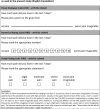Psychometric properties of three single-item pain scales in patients with rheumatoid arthritis seen during routine clinical care: a comparative perspective on construct validity, reproducibility and internal responsiveness - PubMed (original) (raw)
Psychometric properties of three single-item pain scales in patients with rheumatoid arthritis seen during routine clinical care: a comparative perspective on construct validity, reproducibility and internal responsiveness
Melanie Sendlbeck et al. RMD Open. 2015.
Abstract
Objective: To investigate the construct validity, reproducibility (ie, retest reliability) and internal responsiveness to treatment change of common single-item scales measuring overall pain in patients with rheumatoid arthritis (RA) and to investigate the corresponding effect of common pain-related comorbidities and medical consultation on these outcomes.
Methods: 236 patients with RA completed a set of questionnaires including a visual analogue scale (VAS), a numerical rating scale (NRS) and a verbal rating scale (VRS) measuring overall pain before and immediately after routine medical consultation as well as 1 week after the patient's visit. Construct validity and retest reliability were evaluated using the Bravais-Pearson correlation while standardised response means (SRM) were calculated for evaluating internal responsiveness. Differences in the perception of pain were calculated using dependent samples t-tests.
Results: In the total sample, construct validity was good across all three time points (convergent validity of pain scales: rT1-T3=0.82-0.92, p<0.001; discriminant validity as correlation of pain scales with age: rage=0.01-0.16, p>0.05). In patients maintaining antirheumatic treatment, retest reliability of pain scales was confirmed for all scales and across time points (rVAS=0.82-0.95, rNRS=0.89-0.98, rVRS=0.80-0.90, p<0.001), while the internal responsiveness of scales to a change in treatment was low across all scales (SRM=0.08-0.21). The VAS especially suggested a change in pain perception after medical consultation in patients maintaining therapy.
Conclusions: The VAS, NRS and VRS are valid and retest reliable in an outpatient clinical practice setting. The low pain scales' internal responsiveness to treatment change is likely to be due to the short follow-up period. Patients with RA maintaining antirheumatic therapy seem to experience less pain after medical consultation.
Keywords: Outcomes research; Patient perspective; Psychology; Rheumatoid Arthritis.
Figures
Figure 1
The visual analogue scale, the numerical rating scale and the verbal rating scale as used in the present study (English translation).
Figure 2
Correlation coefficients for convergent and discriminant validity.
Figure 3
Mean differences of pain in relation to pain ratings before medical consultation in the total sample.
Similar articles
- Comparison of the construct validity and reproducibility of four different types of patient-reported outcome measures (PROMs) in patients with rheumatoid arthritis.
Renskers L, van Uden RJJC, Huis AMP, Rongen SAA, Teerenstra S, van Riel PLCM. Renskers L, et al. Clin Rheumatol. 2018 Dec;37(12):3191-3199. doi: 10.1007/s10067-018-4285-x. Epub 2018 Sep 12. Clin Rheumatol. 2018. PMID: 30209696 - Reliability of pain scales in the assessment of literate and illiterate patients with rheumatoid arthritis.
Ferraz MB, Quaresma MR, Aquino LR, Atra E, Tugwell P, Goldsmith CH. Ferraz MB, et al. J Rheumatol. 1990 Aug;17(8):1022-4. J Rheumatol. 1990. PMID: 2213777 - Measuring functional disability in early rheumatoid arthritis: the validity, reliability and responsiveness of the Recent-Onset Arthritis Disability (ROAD) index.
Salaffi F, Stancati A, Neri R, Grassi W, Bombardieri S. Salaffi F, et al. Clin Exp Rheumatol. 2005 Sep-Oct;23(5 Suppl 39):S31-42. Clin Exp Rheumatol. 2005. PMID: 16273783 - Measuring pain and efficacy of pain treatment in inflammatory arthritis: a systematic literature review.
Englbrecht M, Tarner IH, van der Heijde DM, Manger B, Bombardier C, Müller-Ladner U. Englbrecht M, et al. J Rheumatol Suppl. 2012 Sep;90:3-10. doi: 10.3899/jrheum.120335. J Rheumatol Suppl. 2012. PMID: 22942322 Review. - Studies comparing Numerical Rating Scales, Verbal Rating Scales, and Visual Analogue Scales for assessment of pain intensity in adults: a systematic literature review.
Hjermstad MJ, Fayers PM, Haugen DF, Caraceni A, Hanks GW, Loge JH, Fainsinger R, Aass N, Kaasa S; European Palliative Care Research Collaborative (EPCRC). Hjermstad MJ, et al. J Pain Symptom Manage. 2011 Jun;41(6):1073-93. doi: 10.1016/j.jpainsymman.2010.08.016. J Pain Symptom Manage. 2011. PMID: 21621130 Review.
Cited by
- Update of Modified Version of the Foot Function Index Tool Spanish Version (FFI-Sp), in Patients with Rheumatoid Arthritis: Cross Sectional Study.
Gamez-Guijarro M, Reinoso-Cobo A, Gordillo-Fernandez LM, Ortiz-Romero M, Ortega-Avila AB, Chicharro-Luna E, Gijon-Nogueron G, Lopezosa-Reca E. Gamez-Guijarro M, et al. Medicina (Kaunas). 2024 Aug 18;60(8):1339. doi: 10.3390/medicina60081339. Medicina (Kaunas). 2024. PMID: 39202620 Free PMC article. - Physical pain among family caregivers to older adults: A scoping review of the literature.
Turner SG, Pillemer K, Demetres M, Heaney K, Joshi S, Luebke M, Messay G, Reid MC. Turner SG, et al. J Am Geriatr Soc. 2024 Sep;72(9):2853-2865. doi: 10.1111/jgs.19037. Epub 2024 Jun 19. J Am Geriatr Soc. 2024. PMID: 38895995 Review. - The biobehavioural pain and movement questionnaire (BioPMovQ): development and psychometric validation of a new questionnaire.
La Touche R, Paris-Alemany A, Pardo-Montero J, Miñambres-Martín D, Mercado-Romero F, de la Rosa-Díaz I, Sorrel MA, Grande-Alonso M. La Touche R, et al. Front Med (Lausanne). 2024 May 9;11:1358829. doi: 10.3389/fmed.2024.1358829. eCollection 2024. Front Med (Lausanne). 2024. PMID: 38784228 Free PMC article. - Is new tech a pain in the neck? The impact of introducing new technologies in home-care on neck pain: a prospective study.
Christensen JO, Johannessen H. Christensen JO, et al. BMC Public Health. 2024 Mar 7;24(1):734. doi: 10.1186/s12889-024-18252-z. BMC Public Health. 2024. PMID: 38454440 Free PMC article. - Predictive factors for foot pain in the adult population.
Canca-Sanchez FJ, Morales-Asencio JM, Ortega-Avila AB, Gijon-Nogueron G, Cervera-Garvi P, Marchena-Rodriguez A, Canca-Sanchez JC. Canca-Sanchez FJ, et al. BMC Musculoskelet Disord. 2024 Jan 12;25(1):52. doi: 10.1186/s12891-023-07144-9. BMC Musculoskelet Disord. 2024. PMID: 38216960 Free PMC article.
References
- Schmidt RF, Willis WD, eds. Encyclopedia of pain. Berlin: Springer, 2007.
LinkOut - more resources
Full Text Sources
Other Literature Sources


